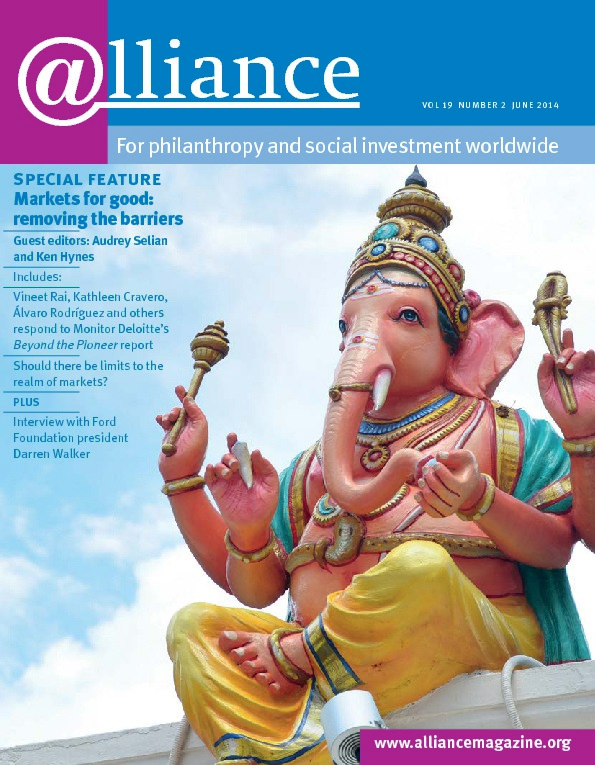As the term ‘impact investing’ has gained prominence over the last five years, many have assumed that it describes a new approach to investing. In fact, some investors have long sought to generate positive social or environmental impact as well as a financial return. The recently increased awareness of impact investing marks a new collaborative global effort to build and support a market that enables more efficient and effective impact investing.
The Global Impact Investing Network (GIIN) was launched under the auspices of the Rockefeller Foundation in 2009 and comprises mission-driven investors from large financial institutions, foundations, family offices, government investment agencies and fund managers. Although working in diverse sectors and among investors with different objectives, these investors welcomed a peer network where they could discuss approaches to impact investing and collaboration. Members of the GIIN Investors’ Council have continued to collaborate, both to launch new impact investing products, such as the African Agricultural Capital Fund, and in partnerships, such as a recently announced collaboration between SNS Impact Investing and the Dutch development finance institution, FMO, on a fund to support small and medium enterprises.
Various other networks and membership groups have also launched or increased programming in impact investing. The European Venture Philanthropy Association, Aspen Network for Development Entrepreneurs, Toniic, Asian Venture Philanthropy Network, Mission Investors Exchange and Philanthropy Australia have all provided support for impact investors. Last year, UK Prime Minister David Cameron launched the Social Impact Investment Taskforce under the auspices of the G8, supporting the impact investing market with the weight of this highly visible government collaboration.
How exactly are these field-building organizations ‘greasing the wheels’ of the impact investing market? A few key examples are outlined below.
Bringing clarity to the market
Defining the practice of impact investing brings transparency to the market, and helps investors and other stakeholders understand the scope and diversity of this emerging field. Earlier this year, the GIIN published an expanded definition of impact investing which was explicit in its inclusion of investments across asset classes, sectors and regions, with return expectations ranging from below-market rate to market rate. The definition also makes explicit the investor’s intention to generate positive social or environmental impact and the expectation for at least a return of capital and, in most cases, a financial return on capital.
Fostering a transparent deal pipeline
In recent years, field-building organizations have been developing tools and resources to support impact investors. Three years ago, the GIIN launched ImpactBase, an online directory of impact investing funds and products, which now has 1,400 investor subscribers. ImpactBase, which has been described by Cambridge Associates as ‘one of the more established resources for sourcing impact investments’, allows them to search the profiles of 300 impact investing vehicles to find those that match their interests. Further illuminating the landscape of impact investing products, ImpactAssets, another field-building organization, releases an annual list of 50 impact investing fund managers, the ImpactAssets50. Other organizations including Intellecap in India, PYMWYMIC in the Netherlands, and Investors’ Circle in the US organize events where impact investors can meet with asset managers and social entrepreneurs presenting investment opportunities.
Promoting consistent impact measurement
As investors recognize the need for a consistent approach to measuring and tracking performance, there has been increasing support for impact measurement. Managed by the GIIN, IRIS is an online catalogue of generally accepted social, environmental and financial metrics used by impact investors. IRIS provides clear standardized definitions for hundreds of metrics that matter to impact investors, including those related to clients, employees, suppliers and other end-beneficiaries of impact investments in sectors such as agriculture, community investment, land conservation and microfinance.
With such diversity in the impact investing market, many IRIS users create customized sets of IRIS metrics to meet their specific objectives. This allows investors to collect data that is measured consistently and can therefore be aggregated and analysed across investments and the market as a whole. Metrics are selected and developed for the IRIS catalogue through a formal and open process that includes review and inclusion of existing third-party standards, input from expert working groups and advisers, and feedback from users and the public during regular open comment periods.
IRIS also provides the basis for additional performance management tools. B Lab, the non-profit organization that has promoted benefit corporations in the US, has also developed the Global Impact Investing Rating System (GIIRS), which provides audited ratings to social enterprises and impact investment funds using a performance and operations survey aligned with IRIS. Similarly, PRISM, a fund performance assessment platform developed by Intellecap, uses IRIS metrics to ensure consistent reporting that reduces the information burden on fund managers and their portfolio companies.
To provide high-level guidance, the Social Impact Investment Taskforce has assembled an international working group on impact measurement. This group will contribute general and practical impact measurement guidelines for impact investors and specific case studies to a report from the Taskforce due out later this year. It will also outline steps towards a more formalized and standardized impact measurement system.
Providing training and education
Increasingly, universities are developing programmes to support rising professionals in the hybrid form of expertise that impact investing requires. In the UK, Oxford’s Said Business School runs an Impact Investing Programme, and in the Netherlands, Maastricht University hosts an executive education programme in impact investing in conjunction with Duisenberg School of Finance. Additionally, since 2011, Northwestern University’s Kellogg School of Management and INSEAD have hosted an international impact investment competition for teams of graduate students pursuing impact investing.
This year, backed by the UK Department for International Development’s Impact Programme, the GIIN launched impact investment professional training and consulting support for fund managers looking to develop expertise in impact investing in Sub-Saharan Africa and South Asia.
Providing market intelligence
Recent years have also seen a boom in research and thought leadership to support the impact investing field, sparking productive dialogues about the most effective ways to increase the resources supporting social and environmental solutions. The responses to the Beyond the Pioneer report from Monitor Deloitte in this issue of Alliance comprise one example of a productive dialogue between the many stakeholders in impact investing. Last year, a similar conversation was hosted in the Stanford Social Innovation Review, where 18 investors and field-builders participated in a conversation about the ways that impact investing can lead to the most meaningful social and environmental impact.
Other research highlights innovative practices in impact investing, such as the GIIN’s report on catalytic first-loss capital, which noted common motivations behind investment partnerships that make use of credit enhancement including first-loss structures. Increasingly, foundations and other providers of credit enhancement recognize that its purpose is not to support the private sector but to utilize the private sector as an instrument of mission. Similarly, 12 case studies of best practices in impact investing fund management were recently detailed in the Impact Investing 2.0 report, jointly produced by the Impact Investing Policy Collaborative, ImpactAssets and the Center for the Advancement of Social Entrepreneurship at Duke University.
Alongside efforts to build this new market have gone attempts to document its overall progress, like the annual ‘state of the market’ survey of impact investors, published by JP Morgan and the GIIN. Since 2010, survey respondents have indicated growth in the size of allocations and number of deals that they plan to make over time. The recently released 2013 version includes 125 respondents who are collectively managing $46 billion in impact investments.
Working together to maintain momentum
Looking ahead, there is tremendous opportunity for positive impact in a market that has attracted so many different types of investor to address some of the world’s most pressing social and environmental challenges. To realize this potential, the impact investing market must be able to efficiently support a broad range of investor goals, approaches and requirements. Collaboration and coordination are key to unlocking this tremendous promise.
Luther Ragin Jr is chief executive officer, Global Impact Investing Network. Email info@thegiin.org




Comments (0)